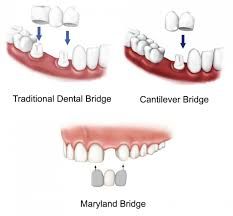Hi everyone, how is the blogging adventure with you all?. Seemingly everything is rocking fine. Well, with taking much longer from your precious moment, let's go to the main scope of this post.
First of, what is Resin-bonded Bridges in dentistry as a sub-branch of Fixed Partial dentures and why are they also called conservative bridges?.
Well, Resin-bonded Bridges by definition are the fixed dental prosthesis that is luted to tooth structures, primarily the enamel that is etched in order to mechanical retention to resin cement.
While they were also called Conservative Bridges because they do not require much intense reduction of the supporting teeth which are the abutments like it is required in the conventional bridges. In resin-bonded bridges the retainer can be reduced to a metal wing and then luted to a minimally prepared abutment tooth with the help of resin cement.
Now let's go to the clinical indications for the use of Resin-bonded Bridges. The indications are many depending on the situations which are as follows:
1- Replacement of missing anterior teeth either in the upper or lower jaw
Though occlusion should be checked and deep bite would make it to be contraindicated if noticed.
2- Treatment of choice in young lads and adolescent patients.
This is so because it does not involve much reduction of tooth and it fits more as replacement for younger patients and paediatrics with large pulp chamber.
3- It could be used in some cases of posterior single teeth replacement.
4- It is a treatment of choice where abutments are without any restorations and have a significant crown length.
5- It could also be used as a splint in periodontically compromised teeth though not as effective in function as traditional or conventional FPDs (Fixed Partial Dentures).
Now, let's go to the contraindications for the choice of Resin-bonded Bridges in treatment:
1- Patients with parafunctional habits such as bruxism, tongue thrusting and so on.
2- Long span saddles or bridges
3- Restored or damaged abutments
4- Compromised enamel structure such as in Enamel hypoplasia, fluorosis, amelogenesis imperfecta.
5 - Significant deep bite in anterior teeth or deep vertical overlap of the general dentition.
6- Patient with allergies to nickel due to the material used the making of the bridges.
That's all as regards the Resin-bonded Bridges atleast for now. In the subsequent posts we discuss on advantages and its disadvantages of its choice of treatment.
Thanks your precious moment and Happy Blurting🎉
Reference
